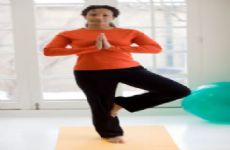|
September is National Yoga Month, so there's no better time to summon the courage to give it a try. You've heard all about how yoga can help increase flexibility, decrease stress and even relieve minor back pain. You've dispelled the myths that all yogis are human pretzels who wear skimpy clothes and patchouli. Now it's time to find a yoga studio or a class at your gym and head to class. In my classes, I always try to approach new students before class begins to ease any apprehension they might have and answer questions. Here's a primer to help you feel right at home on the mat! While yogis are known for their kindness and compassion, no one wants to make a fitness faux pas! Shoes Yoga is practiced barefoot, so be prepared. There's no need to get a pedicure for the occasion, but I like to give my feet a quick rinse before class, especially if they've been cooped up in closed-toe shoes all day. You spend a great deal of time focusing on gripping your feet, spreading your toes and evenly distributing your weight over your entire feet. Sweaty, dirty feet stick to yoga mats, and if you have lotion or cream on your feet, you can slip. Wear whatever shoes you'd like to the class, but take your shoes off before entering the yoga room. Most studios have shelves for shoes either just inside the door or in the lobby. At a gym, most people take off their shoes as they enter the room. Clothes Comfort is important during a yoga class. You'll be spending a good deal of time bending, stretching and twisting your body, so you'll want to wear something that will stay put. You will want to avoid clothes that are so tight that they impede breathing or make it difficult to move. Shorts and loose shirts often move around and expose too much skin, while skintight running tights make it hard to move your body. Opt for cotton or sweat-absorbing microfiber fabrics. Longer sleeveless tops are a good choice, as are form-fitting pants or cropped pants. Ladies, wear a sports bra, as a regular bra will slip around too much during your practice. Talking Yoga is a quiet, contemplative activity, and students are discouraged from talking throughout the class. The teacher will describe how you will transition from pose to pose and offer encouragement throughout. In addition, you might hear long, complicated-sounding names like Adho Mukha Svanasana (downward-facing dog) and Virabhadrasana (warrior). Teachers often include the traditional Sanskrit names of poses, but most beginners classes will use the English names. In addition, you might hear the words drishti (gaze), bandhas (energy locks), asanas (poses), among other Sanskrit words. If there is a word you don't understand, feel free to ask the teacher about it after class. Time A yoga class often begins with a few minutes of relaxation and meditation to prepare your mind and body for your practice. This might be in the form of deep breathing, a chant of "om" or some visualization exercises. So that you don't miss this important aspect or disturb others who are trying to focus, try to come to class about five or 10 minutes early. You can chat with the teacher, warm up with a few stretches (though you will warm up during class) and get settled on your mat. Yoga classes last between 45 and 90 minutes. Most beginners classes are shorter, while advanced classes are longer. Breathing As with any physical activity, the breath is very important in yoga. The first time you hear people breathing during yoga, you might think that a snake is loose in the room. The traditional breath, called "ujjayi" breath, is slow and even inhales and exhales through the nose. The back of the throat is constricted slightly to create a filter for the breath and generate heat. The audible breath is used as a "moving meditation" throughout the practice. Focusing on the sound and cadence of the breath helps calm your mind, especially during more difficult poses. When you encounter a pose that is challenging, focus on your breath and imagine breathing into the part of your body that feels discomfort. It will help you build endurance. Movement While there are a variety of different philosophies and styles of yoga, classes can be broken into two basic groups: hatha and vinyasa. Hatha is a generic term that has come to mean gentle yoga. A hatha class is usually good for beginners, and there will be breaks between poses. You will return to a neutral, restorative seated or standing pose between more difficult poses. Vinyasa means flow, which indicates that a class will have fewer resting poses. You will transition from pose to pose, with no actual rest. Each pose will be held for a certain amount of time (5-8 breaths is common) before you move on to another pose, often using a series of movements called sun salutations to transition. If you ever need a break during the class, you can take child's pose, which is a restorative pose. Kneel on the floor, spreading your legs if need be, sit your hips onto your heels and extend your arms either overhead to stretch the length of the back or alongside the hips, to stretch across the top of the back. Music Many contemporary yoga classes are accompanied by music. Some teachers might choose Sanskrit chants as their soundtrack of choice, while others might choose hits from the radio. Music is not played during more traditional yoga classes, when students are encouraged to listen to and focus on their breath. Chanting Many teachers begin and end yoga classes with a chant, most commonly "Om." Feel free to join in the chant or listen quietly until you feel comfortable. This is another way you start to quiet and focus the mind during a yoga class. Touching Yoga teachers are trained to adjust students to keep them in proper alignment, help them go deeper into a pose and try out a pose they might not feel strong enough to attempt on their own. Don't be surprised if your yoga teacher is more "hands on" than other fitness instructors you've encountered. Teachers are usually pretty good at gauging a student's willingness to be assisted/touched. If you feel uncomfortable with hands-on adjustments, feel free to let your teacher know. Water There are no designated water breaks during class, and traditionally students are discouraged from drinking during class as it extinguishes the "fire" you're trying to create through your breath and movement. You might notice many students never stop to take a drink and others stop to towel off and get a drink periodically. Bringing a water bottle to class is acceptable, and drink as much and as often as you need, especially during hot yoga classes. Rest At the end of each yoga class, there is a time for rest and reflection. Teachers might lead a chant or guided meditation, and they will encourage you to relax your mind and focus your attention. It's tradition to sit in a crossed-leg position with your feet on top of the legs (lotus pose), but find a position that makes you feel comfortable. (While you might feel like your "workout" is over, you should stick around for the final relaxation poses. If you need to leave class a few minutes early for whatever reason, notify your teacher before class and leave before Savasana begins.) Eventually, you will make your way to your back, arms and legs resting comfortably at your sides and your palms facing up. You'll close your eyes and focus on relaxing. Try to lie still and clear your mind. This pose, called Savanasa or corpse pose, is a very important part of any yoga practice, as it allows the body to rest and rejuvenate itself. When it's time to come out of Savasana, your teacher will quietly tell you to wiggle your fingers and toes. Make small movements, then roll onto your right side in a fetal position, keeping your eyes closed. Return to a cross-legged seated position, then listen to your teacher's final instructions. Traditionally, the hands are brought to the heart in a prayer position, then brought between the eyebrows and finally overhead. Bow your head to the floor, keeping hands in prayer just in front of you. You'll hear your teacher say "Namaste," and you repeat it back. "Namaste" means "may the light within me honor the light within you." Now you're all set for your first class! In honor of National Yoga Month, many studios are offering a week's worth of classes for free. Find details here. Are you ready to try your first yoga class? What questions do you have about yoga? If you have been taking yoga for awhile, were you nervous when you took your first class? |
More From SparkPeople
|





















